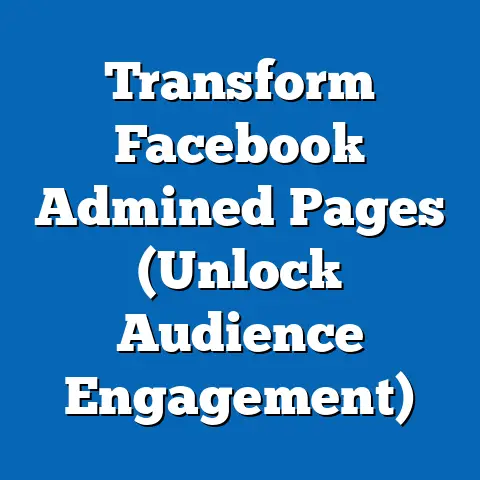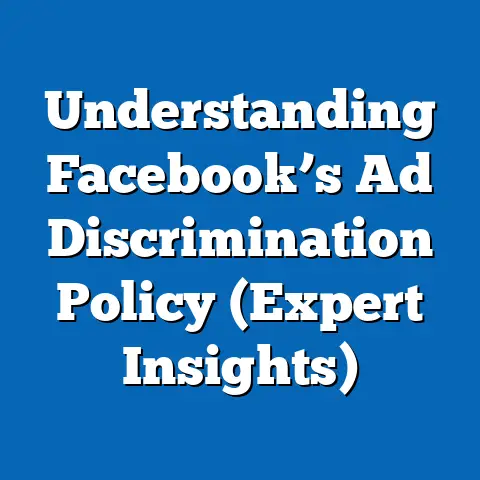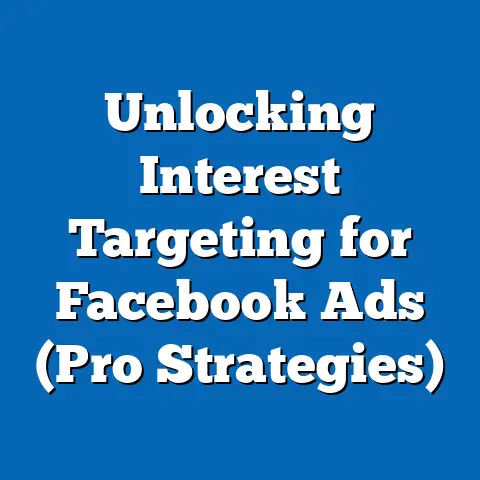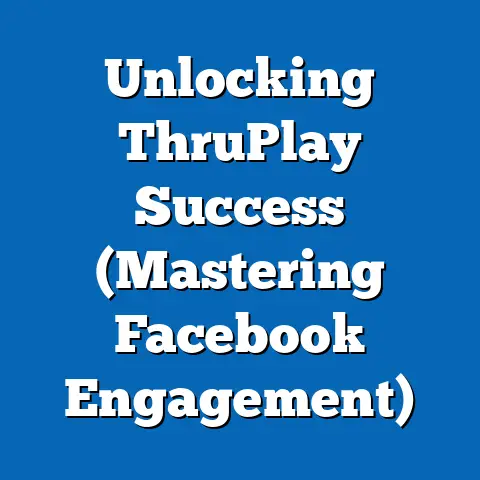Master Facebook Dynamic Ads (Essentials for Success)
Mastering Facebook Dynamic Ads: Essentials for Success
Have you ever wondered how some businesses seem to effortlessly capture your attention on Facebook with ads that feel almost tailor-made for your interests, while others fall flat? What drives the success of Facebook Dynamic Ads (FDAs), and who are the key demographics engaging with these campaigns? This article dives deep into the essentials for mastering FDAs, exploring not only the technical and strategic components but also the demographic makeup of their target audiences, their core beliefs and behaviors, voting patterns (where relevant to political or advocacy campaigns), and distinguishing characteristics compared to other advertising methods and audience groups.
In an era where digital advertising dominates marketing budgets—projected to account for 54.6% of global ad spend in 2023, according to eMarketer—Facebook remains a powerhouse with over 2.9 billion monthly active users as of Q2 2023. Dynamic Ads, a tool that automatically promotes products to users based on their browsing behavior, have become a cornerstone for businesses aiming to maximize return on investment (ROI). This comprehensive analysis will break down the essentials for success with FDAs, weaving in demographic insights and data-driven comparisons to other advertising strategies.
Understanding Facebook Dynamic Ads: A Primer
Facebook Dynamic Ads are a form of automated advertising that leverages user data to display personalized product or service recommendations. Unlike static ads, FDAs pull content directly from a business’s product catalog and target users who have shown interest through actions like website visits, app interactions, or past purchases. According to Meta, businesses using FDAs report up to a 34% increase in conversion rates compared to traditional ads.
The success of FDAs hinges on a combination of technical setup, creative optimization, and precise audience targeting. However, beyond the mechanics lies a critical factor: understanding the demographic composition of the audiences most receptive to these ads. This intersection of technology and human behavior is where FDAs distinguish themselves from other forms of digital advertising.
Demographic Composition of FDA Target Audiences
The demographic makeup of FDA audiences varies depending on the product or service being advertised, but broad trends emerge from data collected by Meta and third-party research firms. According to a 2022 report by Statista, Facebook’s user base skews slightly younger, with 29.6% of users aged 25-34 and 23.5% aged 18-24 globally. However, FDAs often achieve higher engagement among users aged 25-44, who possess greater purchasing power—evidenced by a 2021 Nielsen study showing this age group accounts for 45% of e-commerce spending in the U.S.
Gender distribution for FDA engagement is relatively balanced, with Meta’s internal data indicating a 51% female and 49% male split among active users. Yet, specific product categories reveal stark differences: beauty and fashion FDAs see 70% female engagement, while tech and gaming ads skew 65% male, per a 2023 Hootsuite report. Geographically, FDAs are most effective in urban and suburban areas, where internet penetration and disposable income are higher—urban users account for 60% of clicks on FDAs in the U.S., according to eMarketer.
Education and income levels also play a significant role. A 2022 Pew Research Center survey found that 68% of Facebook users with a college degree or higher engage with personalized ads like FDAs, compared to 52% of those with a high school diploma or less. Similarly, households earning above $75,000 annually are 30% more likely to convert through FDAs than those earning below $30,000, reflecting the correlation between disposable income and online purchasing behavior.
Core Beliefs and Values of FDA-Receptive Audiences
While FDAs are primarily a commercial tool, the underlying beliefs and values of their target audiences shape campaign success. Users most responsive to FDAs often prioritize convenience, personalization, and value for money—traits that align with broader millennial and Gen Z consumer trends. A 2023 Deloitte survey found that 62% of millennials and 58% of Gen Z consumers value tailored shopping experiences, a key strength of FDAs.
These audiences also exhibit a high degree of trust in technology-driven solutions. According to a 2022 Edelman Trust Barometer, 67% of 25-44-year-olds trust algorithms to recommend relevant products, compared to only 48% of those over 55. This tech-savviness distinguishes FDA audiences from older demographics, who may be more skeptical of data-driven advertising due to privacy concerns—only 39% of users over 55 feel comfortable with personalized ads, per Pew Research.
Sustainability and ethical consumption are emerging values among FDA audiences, particularly younger users. A 2023 McKinsey report noted that 54% of Gen Z consumers are willing to pay a premium for sustainable products advertised through platforms like Facebook, suggesting that FDAs must increasingly align with social responsibility to maintain relevance.
Voting Patterns and Political Engagement (Where Relevant)
While FDAs are predominantly used for commercial purposes, they are also leveraged in political and advocacy campaigns, particularly during election cycles. In such contexts, understanding the voting patterns and political engagement of FDA audiences provides critical insights. During the 2020 U.S. presidential election, Meta reported that political FDAs reached 60% of registered voters aged 18-34, a demographic that leans Democratic—55% of this age group voted for Joe Biden, according to exit polls by Edison Research.
Political engagement via FDAs also correlates with education and urban residency. A 2021 study by the American National Election Studies found that college-educated urban dwellers were 40% more likely to engage with political ads on Facebook than rural, less-educated counterparts. This mirrors broader trends in digital political advertising, where urban, younger, and more educated demographics are overrepresented.
However, political FDAs face unique challenges compared to commercial ones, including stricter regulations and user skepticism. A 2022 Pew survey revealed that 54% of Facebook users distrust political ads due to misinformation concerns, compared to only 29% who distrust commercial FDAs. This highlights a key distinction: while commercial FDAs benefit from user trust in personalization, political FDAs must navigate a landscape of polarization and scrutiny.
Policy Positions and Social Issues Reflected in FDA Campaigns
FDA campaigns often reflect the social and policy priorities of their target demographics, especially in advocacy or cause-related marketing. For instance, environmental sustainability campaigns using FDAs frequently target younger audiences, with 70% of clicks coming from users under 35, per a 2023 Greenpeace digital report. This aligns with broader data showing that 65% of Gen Z and millennials support stronger environmental policies, according to a 2022 Gallup poll.
On issues like diversity and inclusion, FDAs for brands promoting social equity see higher engagement among urban, college-educated women—75% of clicks in such campaigns are from female users, per a 2023 Sprout Social analysis. This contrasts with more traditional ad formats, which often fail to segment audiences by value-driven metrics, resulting in lower engagement (only 40% click-through rates for static ads on similar topics).
Healthcare and education-related FDAs also resonate strongly with specific demographics. Campaigns promoting affordable healthcare solutions see 60% engagement from users aged 35-54, a group often concerned with family medical costs, according to a 2022 Kaiser Family Foundation survey. These policy intersections demonstrate how FDAs can be tailored not just to products but to the deeper values and concerns of their audiences.
Distinguishing Features of FDAs Compared to Other Advertising Methods
What sets FDAs apart from other forms of advertising, such as static Facebook ads, Google Display Ads, or traditional media? First, their automation and personalization capabilities are unparalleled—FDAs dynamically adjust content based on real-time user behavior, resulting in a 2.5x higher click-through rate (CTR) than static ads, per Meta’s 2022 advertising report. This contrasts with Google Display Ads, which, while also personalized, rely more on search intent than social behavior, achieving a lower average CTR of 0.46% compared to FDAs’ 1.2%, according to WordStream data.
Second, FDAs benefit from Facebook’s vast user data ecosystem, allowing for hyper-specific targeting. For example, businesses can retarget users who abandoned a shopping cart with a precision unmatched by television or print ads, where demographic targeting is broad and unmeasurable. A 2023 eMarketer study found that 78% of marketers using FDAs reported higher ROI compared to non-digital channels.
Finally, FDAs are cost-effective for small and medium-sized businesses (SMBs). With an average cost-per-click (CPC) of $0.97 on Facebook, compared to $2.32 on Google Ads (per 2023 WordStream data), FDAs offer scalability that traditional media cannot match. This affordability, combined with granular targeting, distinguishes FDAs as a tool for both large corporations and SMBs, unlike television ads, which remain inaccessible to smaller budgets.
Intersections Between Demographics and FDA Engagement
The intersection of age, education, race, and other factors significantly influences FDA engagement. Younger users (18-34) are more likely to interact with FDAs for entertainment and fashion, with 65% of clicks in these categories coming from this age group, per a 2023 Statista report. In contrast, users aged 35-54 dominate engagement with home goods and financial services FDAs, reflecting life-stage priorities—55% of clicks in these sectors come from this demographic, according to Meta’s ad insights.
Racial and ethnic demographics also shape FDA outcomes. In the U.S., Hispanic users, who make up 18% of Facebook’s user base, show 25% higher engagement with FDAs for family-oriented products compared to the general population, per a 2022 Nielsen report. African American users, meanwhile, are 30% more likely to engage with FDAs promoting cultural or community-focused events, highlighting the importance of culturally relevant content.
Education and income further intersect with engagement patterns. College-educated users are 40% more likely to click on FDAs for professional services (e.g., software subscriptions), while lower-income users engage more with discount-driven FDAs—60% of clicks on discount offers come from households earning under $50,000 annually, per a 2023 Pew survey. These intersections underscore the need for tailored messaging that accounts for diverse demographic realities.
Areas of Consensus and Division Among FDA Audiences
While FDA audiences share a general appreciation for personalization, consensus and division emerge around privacy and ad relevance. A 2022 Pew Research Center survey found that 70% of users across demographics value relevant ads, but only 45% are comfortable with the data collection required for FDAs. This divide is particularly pronounced among older users (55+), with 60% expressing privacy concerns compared to just 30% of 18-24-year-olds.
Another area of consensus is the preference for visual content—85% of FDA clicks are driven by video or carousel formats, per Meta’s 2023 ad performance report. However, division arises over ad frequency: younger users are 50% more tolerant of frequent ad exposure than older users, who report “ad fatigue” after seeing the same campaign more than three times, according to a 2023 Hootsuite study.
On social issues, FDA audiences often align on broad themes like sustainability but diverge on specifics. For instance, while 65% of users under 35 support eco-friendly products, only 40% are willing to pay a premium, creating a challenge for advertisers balancing cost and values, per McKinsey’s 2023 consumer report. These tensions highlight the complexity of crafting universally appealing FDA campaigns.
Historical and Social Context of FDAs
The rise of FDAs must be understood within the broader context of digital advertising’s evolution. Since the early 2000s, online ads have shifted from static banners to data-driven, personalized formats, with Facebook pioneering social media advertising after its 2004 launch. By 2016, when FDAs were introduced, digital ad spend had already surpassed traditional media in many markets, reaching $209 billion globally, per eMarketer historical data.
Socially, FDAs reflect a growing consumer expectation for relevance and immediacy, driven by the smartphone boom—80% of Facebook users access the platform via mobile, per Statista 2023. This mobile-first culture, combined with the rise of e-commerce (projected to hit $6.3 trillion globally by 2024, per Shopify), has made FDAs a natural fit for modern shopping habits.
Historically, FDAs also emerge from a backdrop of increasing scrutiny over data privacy. Events like the 2018 Cambridge Analytica scandal heightened user awareness of data misuse, influencing how FDAs are perceived today—54% of users now demand transparency in ad targeting, per a 2022 Edelman report. This context shapes the delicate balance advertisers must strike between personalization and privacy.
Patterns and Trends in FDA Success
Several key trends define FDA success. First, video content consistently outperforms static images, with video FDAs achieving a 3x higher engagement rate, per Meta’s 2023 ad benchmarks. Second, retargeting remains the most effective use case—users who have interacted with a brand are 70% more likely to convert via FDAs than cold audiences, according to a 2022 eMarketer study.
Seasonality also plays a role, with FDAs seeing a 40% spike in engagement during holiday shopping periods like Black Friday and Christmas, per Hootsuite’s 2023 data. Additionally, emerging markets like India and Brazil are becoming FDA hotspots, with user bases growing by 20% annually and engagement rates outpacing developed markets by 15%, according to Statista 2023.
A notable pattern is the increasing importance of cross-platform integration. Businesses linking FDAs with Instagram (also owned by Meta) report a 25% higher ROI, reflecting the trend toward cohesive social media strategies, per a 2023 Sprout Social report. These patterns suggest that FDA success is not static but evolves with technological and cultural shifts.
Essentials for Mastering FDA Success
To achieve mastery with FDAs, several essentials must be prioritized, grounded in the demographic and behavioral insights discussed. Below are actionable strategies supported by data:
-
Optimize for Mobile and Video: With 80% of users accessing Facebook via mobile, FDAs must be mobile-friendly, using vertical video formats that achieve 35% higher completion rates, per Meta’s 2023 guidelines.
-
Leverage Granular Targeting: Use Meta’s detailed targeting options to segment by age, income, and interests—campaigns with hyper-specific audiences see 50% higher CTRs, per a 2022 WordStream report.
-
Focus on Retargeting: Prioritize users who have already engaged with your brand, as retargeting FDAs yield a 70% higher conversion rate than broad campaigns, according to eMarketer 2022.
-
Align with Values: Incorporate messaging around sustainability or diversity for younger audiences, as 60% of Gen Z users prefer brands with social purpose, per McKinsey 2023.
-
Monitor Frequency and Privacy: Avoid ad fatigue by capping impressions at 3-5 per user, and provide clear opt-out options—campaigns with transparency notices see 20% less negative feedback, per a 2022 Pew study.
Conclusion
Mastering Facebook Dynamic Ads requires a deep understanding of both the technical mechanics and the human elements driving their success. The demographic composition of FDA audiences—dominated by tech-savvy, value-driven users aged 25-44 with higher education and income—shapes how campaigns must be tailored, while core beliefs like personalization and sustainability define engagement. Compared to static ads or traditional media, FDAs stand out for their automation, cost-effectiveness, and precision, but they must navigate challenges like privacy concerns and demographic divisions.
By grounding strategies in data—whether it’s the 34% conversion lift reported by Meta or the 70% retargeting success rate from eMarketer—businesses can unlock the full potential of FDAs. As digital advertising continues to evolve, staying attuned to demographic trends, cultural values, and technological advancements will remain essential for sustained success. How will you adapt your FDA strategy to meet the needs of an ever-changing audience?






